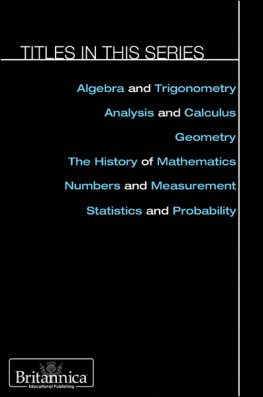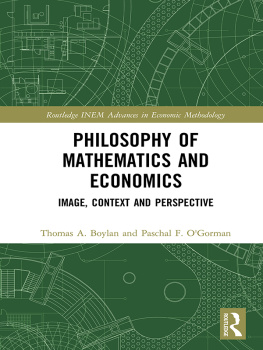The Britannica Guide to
the History of Mathematics
MATH EXPLAINED
The Britannica Guide to
the History of Mathematics
EDITED BY ERIK GREGERSEN, ASSOCIATE EDITOR, ASTRONOMY AND SPACE EXPLORATION

Published in 2011 by Britannica Educational Publishing
(a trademark of Encyclopdia Britannica, Inc.)
in association with Rosen Educational Services, LLC
29 East 21st Street, New York, NY 10010.
Copyright 2011 Encyclopdia Britannica, Inc. Britannica, Encyclopdia Britannica, and the Thistle logo are registered trademarks of Encyclopdia Britannica, Inc. All rights reserved.
Rosen Educational Services materials copyright 2011 Rosen Educational Services, LLC.
All rights reserved.
Distributed exclusively by Rosen Educational Services.
For a listing of additional Britannica Educational Publishing titles, call toll free (800) 237-9932.
First Edition
Britannica Educational Publishing
Michael I. Levy: Executive Editor
J.E. Luebering: Senior Manager
Marilyn L. Barton: Senior Coordinator, Production Control
Steven Bosco: Director, Editorial Technologies
Lisa S. Braucher: Senior Producer and Data Editor
Yvette Charboneau: Senior Copy Editor
Kathy Nakamura: Manager, Media Acquisition
Erik Gregersen: Associate Editor, Astronomy and Space Exploration
Rosen Educational Services
Hope Lourie Killcoyne: Senior Editor and Project Manager
Bethany Bryan: Editor
Nelson S: Art Director
Cindy Reiman: Photography Manager
Matthew Cauli: Designer, Cover Design
Introduction by John Strazzabosco
Library of Congress Cataloging-in-Publication Data
The Britannica guide to the history of mathematics / edited by Erik Gregersen.1st ed.
p. cm.(Math explained)
In association with Britannica Educational Publishing, Rosen Educational Services.
Includes bibliographical references and index.
ISBN 978-1-61530-221-5 (eBook)
1. MathematicsHistory. I. Gregersen, Erik. II. Title: History of mathematics.
QA21.B84 2011
510.9dc22
2010008356
On the cover: Hands with abacus, an old-fashioned counting device. Jed Share/Photodisc/Getty Images
On : Illustrating Pythagorass theorem, this diagram comes from a mid-19th-century edition of the Elements of Euclid, a seminal multi-book series incorporating the findings of both mathematicians. SSPL via Getty Images
On : A page from Newtons annotated copy of Elements, Euclids treatise on geometry. Hulton Archive/Getty Images
On pages : This diagram from Newtons Principia Mathematica concerns hourly variations of the lunar orbit. SSPL via Getty Images
INTRODUCTION

I t seems impossible to believe that at one point in ancient time, human beings had absolutely no formal mathematicsthat from scratch, the ideas for numbers and numeration were begun, applications found, and inventions pursued, one layered upon another, creating the very foundation of everyday life. So dependent are we upon this mathematic basewherein we can do everything from predict space flight to forecast the outcomes of elections to review a simple grocery billthat to imagine a world with no mathematical concepts is quite a difficult thought to entertain.
In this volume we encounter the humble beginnings of the ancient mathematicians and various developments over thousands of years, as well as modern intellectual battles fought today between, for example, the logicians who either support the mathematic philosophy of Platonism or promote its aptly named rival, anti-Platonism. We explore worldwide math contributions from 4000 BCE through today. Topics presented from the old world include mathematical astronomy, Greek trigonometry and mensuration, and the ideas of Omar Khayyam. Contemporary topics include isomorphic structures, topos theory, and computers and proof.
We also find that mathematic discovery was not always easy for the discoverers, who perhaps fled for their lives from Nazi threats, or created brilliant mathematical innovation while beleaguered by serious mental problems, or who pursued a mathematic topic for many years only to have another mathematician suddenly and quite conclusively prove that what had been attempted was all wrong, effectively quashing years of painstaking work. For the creative mathematician, as for those who engage in other loves or conflicts, heartbreak or disaster might be encountered. The lesson learned is one in courage and the pure guts of those willing to take a chanceeven when most of the world said no.
Entering into math history is a bit like trying to sort through a closet full of favourite old possessions. We pick up an item, prepared to toss it if necessary, and suddenly a second and third look at the thing reminds us that this is fascinating stuff. First thing we know, a half hour has passed and we are still wondering how, for instance, the Babylonians (c. 2000 BCE) managed to write a table of numbers quite close to Pythagorean Triples more than 1,000 years before Pythagoras himself (c. 500 BCE) supposedly discovered them.
The modern-day math student lives and breathes with her math teachers voice ringing in her ear, saying, Memorize these Pythagorean triples for the quiz on Friday. Babylonian students might have heard the same request. Their triples were approximated by the formula of the day, a2 + b2/2a, which gives values close to Pythagorass more accurate a2 + b2 = c2. Consider that such pre-Pythagorean triples were written by ancient scribes in cuneiform and sexagesimal (thats base 60). One such sexagesimal line of triples from an ancient clay tablet of the time translates to read as follows: 2, 1 59, 2 49. (The smaller space shown between individual numbers, such as the 1 and the 59 in the example, are just as one would leave a slight space if reporting in degrees and minutes, also base 60). In base 10 this line of triples would be 120, 119, 169. The reader is invited for old times sake to plug these base 10 numbers into the Pythagorean Formula a2 + b2 = c2 to verify the ancient set of Pythagorean triples that appeared more than 1,000 years before Pythagoras himself appeared.
An equally compelling example of credit for discovery falling upon someone other than the discoverer is found in a quite familiar geometrically appearing set of numbers. Most math students recognize the beautiful Pascals Triangle and can even reproduce it, given pencil and paper. The triangle yields at a glance the coefficients of a binomial expansion, among many other bits of useful mathematics information. As proud as Blaise Pascal (1600s) must have been over his Pascals triangle, imagine that of Zhu Shijie (a.k.a. Chu Shih-Chieh), who first published the triangle in his book, Precious Mirror of Four Elements (1303). Zhu probably did not give credit to Pascal, as Pascal would not be born for another 320 years.
Zhus book has a gentle kind of title that suggests the generous sort of person Zhu might have been. Indeed, he gave full credit for the aforementioned triangle to his predecessor, Yang Hui (1300), who in turn probably lifted the triangle from Jia Xian (c. 1100). In fact, despite significant contributions to math theory of his times, Zhu unselfishly referred to methods in his book as
Next page


















